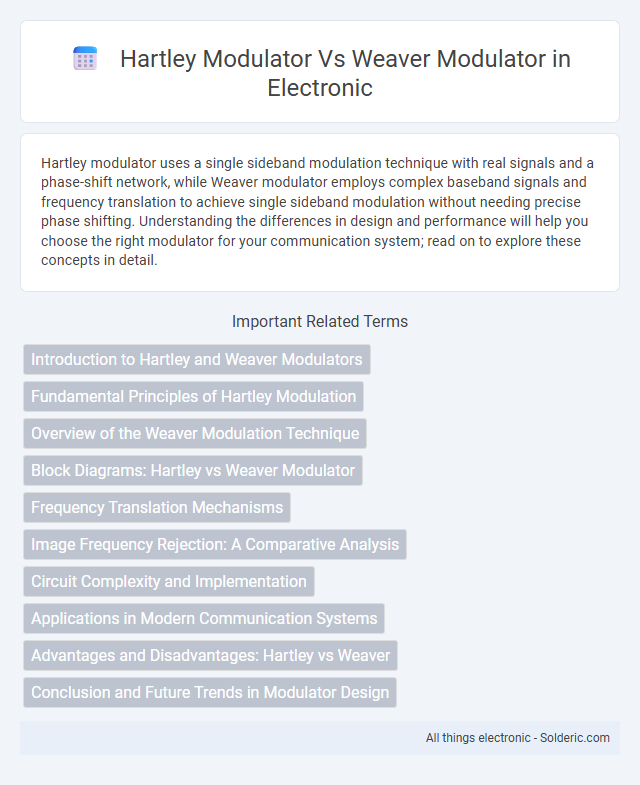Hartley modulator uses a single sideband modulation technique with real signals and a phase-shift network, while Weaver modulator employs complex baseband signals and frequency translation to achieve single sideband modulation without needing precise phase shifting. Understanding the differences in design and performance will help you choose the right modulator for your communication system; read on to explore these concepts in detail.
Comparison Table
| Feature | Hartley Modulator | Weaver Modulator |
|---|---|---|
| Modulation Type | Double Sideband Suppressed Carrier (DSB-SC) | Single Sideband (SSB) |
| Operating Principle | Uses phase-shift network and balanced mixer to generate modulation | Employs quadrature mixing and low-pass filtering to select single sideband |
| Signal Components | Both Upper and Lower Sidebands transmitted | Only one sideband (Upper or Lower) transmitted |
| Frequency Translation | Not inherently used | Intermediate frequency translation for sideband selection |
| Complexity | Simple circuit design | More complex due to quadrature mixers and filters |
| Bandwidth Efficiency | Less efficient, uses double bandwidth | More efficient, uses half bandwidth of DSB |
| Application | Basic amplitude modulation systems | High-quality single sideband communication systems |
Introduction to Hartley and Weaver Modulators
Hartley modulators use a single carrier frequency combined with a phase-shifted version of the input signal to achieve amplitude modulation, making them efficient for double-sideband suppressed-carrier (DSB-SC) transmission. Weaver modulators employ quadrature carriers and lowpass filtering to generate single-sideband (SSB) signals, providing better sideband suppression and spectral efficiency. Your choice between these modulators depends on the specific communication system requirements for bandwidth and signal complexity.
Fundamental Principles of Hartley Modulation
The Hartley modulator operates on the principle of generating amplitude modulation through the combination of a carrier signal with a baseband message, employing phase shifts to achieve double sideband suppressed carrier (DSB-SC) transmission. This technique emphasizes the use of two quadrature carriers and a 90-degree phase difference to create the modulated output without the carrier frequency component. The resulting signal maintains spectral efficiency and reduces power consumption compared to conventional amplitude modulation methods.
Overview of the Weaver Modulation Technique
The Weaver modulation technique employs a unique quadrature demodulation process, converting high-frequency signals into baseband components to minimize distortion and improve spectral efficiency. Unlike the Hartley modulator, the Weaver method uses a complex signal processing approach involving two mixers and low-pass filters to achieve precise frequency translation. This technique is particularly effective in reducing image frequency interference, enhancing signal clarity in communication systems.
Block Diagrams: Hartley vs Weaver Modulator
The Hartley modulator block diagram consists of two oscillators producing signals that are mixed with the input signal, followed by a summing stage to produce the output, making it effective for single-sideband (SSB) modulation. The Weaver modulator block diagram includes two quadrature mixers, low-pass filters, and a local oscillator generating in-phase and quadrature signals, enabling the suppression of unwanted sidebands through complex signal processing. Your choice between these modulators depends on system requirements for phase accuracy and complexity, as the Hartley modulator offers simplicity while the Weaver modulator provides enhanced sideband selectivity.
Frequency Translation Mechanisms
Hartley modulators utilize a single carrier frequency and rely on multiplying the input signal by quadrature carriers to achieve frequency translation, making them simpler but limited in handling complex signals. Weaver modulators implement a complex mixing process with two stages of frequency translation, effectively shifting the signal to baseband using in-phase and quadrature components, which enhances image rejection and reduces distortion. Your choice between the two depends on the specific modulation requirements, where Weaver modulators excel in suppressing unwanted sidebands through their advanced frequency translation mechanisms.
Image Frequency Rejection: A Comparative Analysis
Hartley modulators generally exhibit moderate image frequency rejection due to their reliance on single-quadrature signal processing, which can allow some unwanted image signals to pass through. Weaver modulators leverage quadrature mixing and filtering techniques, providing superior image frequency rejection by effectively canceling out image components during baseband processing. Your choice between the two modulators impacts system performance, especially in environments where minimizing image frequency interference is critical.
Circuit Complexity and Implementation
Hartley modulators feature simpler circuit designs with fewer components, making them easier to implement in analog systems compared to Weaver modulators. Weaver modulators require more complex architectures, including additional mixers and filters, which increase the overall implementation complexity. The increased circuit complexity of Weaver modulators often leads to higher power consumption and design challenges in integrated circuit applications.
Applications in Modern Communication Systems
Hartley modulators, known for their simplicity and efficient frequency translation, are commonly utilized in low-power RF transceivers within IoT devices and short-range wireless systems. Weaver modulators, offering superior image rejection and enhanced signal fidelity, are preferred in advanced communication platforms such as software-defined radios and broadband multicarrier systems. Both modulators play crucial roles in modern communication by balancing complexity, performance, and application-specific requirements.
Advantages and Disadvantages: Hartley vs Weaver
The Hartley modulator features simpler circuitry and easier implementation, making it ideal for narrowband applications, but suffers from phase distortion and lower image rejection compared to the Weaver modulator. The Weaver modulator provides superior image suppression and better performance in wideband systems but requires more complex quadrature filters and higher computational resources. Your choice depends on system requirements, balancing simplicity against spectral purity and bandwidth needs.
Conclusion and Future Trends in Modulator Design
Hartley modulators offer simplicity and ease of implementation, while Weaver modulators provide superior image rejection and better frequency translation performance. Emerging trends in modulator design emphasize integration with software-defined radio (SDR) platforms and the use of advanced digital signal processing techniques to improve flexibility and spectral efficiency. Your choice should align with future-proofing strategies that incorporate adaptive modulation schemes and low-power design innovations.
Hartley modulator vs Weaver modulator Infographic

 solderic.com
solderic.com